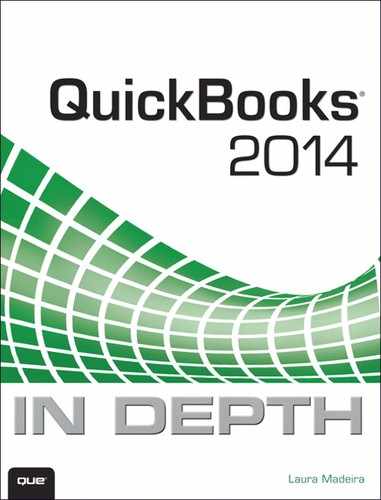1. Getting Started with QuickBooks
This comprehensive reference book offers the reader clear and concise step-by-step written instructions accompanied by detailed illustrations for using QuickBooks Pro, Premier 2014, Premier Accountant 2014, and QuickBooks Enterprise Solutions 14.0. Written for the business owner, accountant, or bookkeeper, QuickBooks 2014 In Depth offers readers a complete guide to the software they use every day.
Understanding QuickBooks
The QuickBooks software comes in a version that is just right for your business needs. For more details you can search from your Internet browser, the words QuickBooks comparison and select any links that display. A few of the differences are detailed in Table 1.1.
Table 1.1. QuickBooks Software Summary
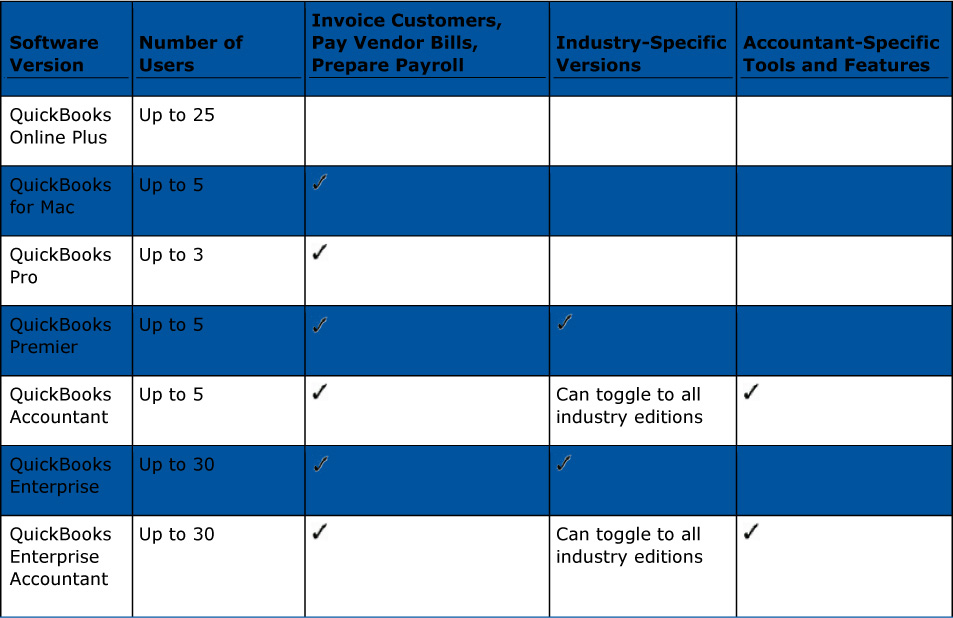
This book does not cover the setup or use of QuickBooks Online or QuickBooks for Mac. The content in this comprehensive guide is for working with QuickBooks Pro, Premier, Accountant, and QuickBooks Enterprise. Most illustrations are from QuickBooks Accountant unless otherwise noted. In some sections, I note when the content or illustrations are from a specific version or industry edition of QuickBooks.
Additionally, this book is a perfect companion to the QuickBooks Essentials LiveLessons video training, combining the best of audio learning and book reference functionality. For more information, see the author’s website: www.quick-training.com
The primary purpose of this book is to teach business owners and accounting professionals how to use QuickBooks software quickly and accurately. Most chapters also include troubleshooting content that sets this book apart from other how-to books. This chapter helps you get started quickly and provides you with quick steps to begin using your QuickBooks software. If you would like to practice what you are learning, open one of the sample files installed with your QuickBooks software. I teach you how to do that first!
Over the years, I have helped hundreds of businesses troubleshoot problems with getting the proper financial and management information out of their QuickBooks data. I have found that improper setup of the data file is most often the primary cause of problems, second only to judgment errors in posting transactions to the incorrect account.
A word of caution: It is not my intention to offer you tax advice; I make comments throughout the text encouraging you to consult your accounting or tax professional before making any data corrections that might have a significant impact on a company’s financials.
Using QuickBooks Sample Data
You can open one of the sample data files installed automatically with your QuickBooks software and begin trying what you are shown in this book. With this data you can test creating transactions, review how lists are set up, and process reports with ready-made data.
The number and type of sample data files installed differ, depending on the version of QuickBooks you purchased.
Caution
Do not enter your own business data into the supplied sample files; they should be used for testing how to create transactions and reviewing reports populated with the sample data only. Additionally, any customizing that you do with the sample data is not saved to other files, including your own business files.
To open a sample file with sample data, follow these steps:
1. Launch QuickBooks from the icon on your desktop.
2. From the menu bar, select File, Close Company. The No Company Open dialog box displays.
3. Click the Open a Sample File button and choose a sample file from the drop-down list as shown in Figure 1.1.
Figure 1.1. Practicing with sample data can help you feel more confident about using QuickBooks.

After creating your own data file, the next time you launch QuickBooks, your file (not the sample file) will default as the file that QuickBooks opens.
Note
This book uses the Sample product-based business file included automatically when you install QuickBooks on the computer. The company name associated with this fictitious data file is Sample Rock Castle Construction. The images and exercises used in the book are from this sample file, but you can read along and practice with any of the installed sample files.
If you want to quickly access previously opened QuickBooks files, including the sample file, from the menu bar, select File, Open Previous Company. QuickBooks displays a list of previous files to choose from.
If you do not see other files listed, you might need to change the number of files displayed on this list. To do so, first open any data file. Then, on the menu bar, select File, Open Previous Company, Set Number of Previous Companies, and enter a number between 1 and 20. The No Company Open dialog box displays the most recent files you have opened with the software.
→ For more information, see “Selecting a Company File to Open,” p. xx.
Tip
Does the No Company Open dialog box include old, unused QuickBooks files? Would you like to see only the QuickBooks files you currently are using?
Click the Edit List link (see Figure 1.2) and place a checkmark next to each company file you want to hide. Click OK to save the changes. Note that the file remains on your computer or server and can later be opened on the menu bar by selecting File, Open or Restore Company.
Figure 1.2. Edit the No Company Open dialog box to remove old, unused data files from the list.

Click here to edit the list of company files displayed.
Creating a New QuickBooks File
If you are new to QuickBooks, the first task is to create a data file. In the No Company Open dialog box, click the Create a New Company button. The QuickBooks Setup dialog box displays the following three options if you are using QuickBooks Pro, Premier (non-accountant), or Enterprise (non-accountant):
• Express Start—Create a file quickly with the least amount of initial setup time.
• Advanced Setup—Formerly called EasyStep Interview. Answer a series of questions to help you set up your new file. If you are using QuickBooks Accountant 2014, you will have additional methods as detailed in this section.
• Other Options—Open an Existing File, Convert Quicken Data, Convert from Other Accounting Software Data, or Set Upon Behalf of Someone Else.
→ To learn more about other options your accounting professional might have with QuickBooks Accountant 2014, see “Creating a New File from an Existing Company File,” p. xx.
Choose from one of the three options that best suits your needs; each one is detailed in the following sections.
Note
Are you working with QuickBooks Accountant 2014 or QuickBooks Enterprise Accountant 14.0? You have the previous options for creating a new file, plus the added method of creating a new company from an existing company file.
What information is copied from the existing company file to the new file? Sales tax items, chart of accounts (with the exception of bank or credit card accounts), and most preferences are copied from the existing file.
What information from the existing file is not copied to the new file? Information not copies includes memorized reports that contain data file-specific filters, memorized transactions, leads, customers, vendors, other names, and employees.
→ If instead of creating a new QuickBooks file you are upgrading your existing file, you can learn more about this process in “Upgrading Your QuickBooks Version,” p. xxx.
Note
The steps detailed here are when using QuickBooks with maintenance release 4 or later. For more information, see “Installing a QuickBooks Maintenance Release,” p. xxx.
Express Start
With Express Start, you can use your new file in just three easy steps (outlined in the following sections). Express Start guides you through the basics of entering your company information, contact information, and—optionally—contacts, products, services, and bank accounts. From the menu bar select File, Create a New Company, and then click the Express Start button in the QuickBooks Setup dialog box. Alternatively, select the Create a New Company button in the No Company Open dialog box and then click the Express Start button.
Step 1—Tell Us
Enter the following information about your business as shown in Figure 1.3:
1. Company Name—This is the name that will be assigned to the file on your computer. This does not have to be your legal name.
2. Industry—QuickBooks uses this to provide you with a sample chart of accounts and for some industries, a sampling of ready-made items that are used throughout QuickBooks when invoicing customers and buying services or products from vendors. Click Help Me Choose to see the choices available for Industry selections.
3. Company Type—QuickBooks uses this to create specific equity accounts used primarily in tax preparation. Click Help Me Choose to see the choices available for Company Type.
4. Tax ID#—QuickBooks uses this information when processing payroll using one of Intuit’s payroll subscription offerings.
5. Do You Have Employees?—Select Yes or No or No, but I might in the future.
Figure 1.3. With Express Start, you can use your file in no time!

When finished, click Continue to advance to the next step in the setup.
Step 2—Contact Info
Complete the following fields of information on the Contact Info dialog box shown in Figure 1.4:
Figure 1.4. Complete the setup by entering your business contact information.

Note
Intuit provides this information about their privacy practices: We value your privacy and security. This information is store safely on Intuit’s servers.
1. Enter the legal name of the business. This will be used in payroll filings.
2. Enter other contact information. The zip code field and phone number field are required when setting up the file. This information will be used to set up a QuickBooks Payments account enabling you to receive payments online from your customers. More information will be sent to the email address you provide in this dialog box.
3. You may choose to select the Preview Your Settings button. Click each of the displayed tabs to see the Features Selected, Chart of Accounts, and Company File Location QuickBooks suggests for you based on your answers in step 1. If you need to change the location where your QuickBooks data file will be stored, on the Company File Location tab, click the Change Location button.
Don’t worry too much about the other settings just yet, because they are easy to modify later in your file and will be addressed in later chapters of the book.
4. Click OK to close the Preview Your Settings dialog box.
5. After completing the required fields, click the Create Company File button to continue to the next step. QuickBooks now creates your file and saves it on your hard drive or to a default location or to the specific location you selected in step 3. Optionally, click the Back button to review or change previous settings.
Step 3—Add Info
Continue with the QuickBooks Setup by adding the people you do business with, your products, services, and bank accounts to your new data file.
If you want to skip these steps, on the bottom of the displayed dialog box (see Figure 1.5), click the Start Working button to launch the QuickBooks Home page.
Figure 1.5. Adding your lists is easy with the QuickBooks Setup Wizard.

Adding People You Do Business With
Now is the perfect time to add the people you do business with to your newly created file. This list includes customers, vendors, and employees. Adding contacts is a three-step process: Choose how to add contacts, select who to add, and review and finish. Later, to learn more about these lists, see Chapter 7, “Setting Up Vendors” and Chapter 9, “Setting Up Customers.”
To add contacts using the QuickBooks Setup Wizard, follow these steps:
1. In the Add the People You Do Business With box (or click Add More if you’ve already entered some names), click the Add button to import or enter the names of people you do business with.
2. If you selected the Add option, you can choose how to add from these choices:
• Import from Outlook, Yahoo!, or Gmail Email—Follow the instructions for importing from one of the listed email providers. You will be able to specify which contacts you want imported into QuickBooks. For Outlook, if you have more than one address book, you can choose which one to use for the import. For other email providers, you might receive an email message that you have shared your address book with QuickBooks.
• Paste from Excel or Enter Manually—Your imported contacts display in the spreadsheet-like form shown in Figure 1.6. Be sure to scroll to the right to see additional data fields. You can also copy and paste from Excel or manually enter contacts directly in the form before importing.
Figure 1.6. Adding the people you do business with is easy when getting started with QuickBooks.

3. If you selected Add More, you are returned to the Add the People You Do Business With dialog box with the same choices as listed in step 2.
Caution
If you choose, you can skip this step and then enter your contact information later. QuickBooks also makes it easy to later edit the information imported into your company data.
4. After importing or entering manually, click Continue to review and finish. QuickBooks Setup checks your list for duplicate names or emails. If any duplicates are detected, you will need to change the Name field (not the Company Name field) so that no duplicates are imported.
5. Click the Fix button to have QuickBooks display any contacts that have duplicate names. Change the Name field to make each unique.
6. Click Continue after fixing. QuickBooks will show how many contacts are ready to be added and how many need to be fixed. Follow step 5 again if needed.
Tip
QuickBooks does not allow you to have duplicated entries in the Name field across the various lists. For example, an employee name cannot be the same as a vendor name. An easy fix for this is to add a “V” to the end of the Name field for the vendor listing who is also included on the employee list.
7. Click Continue. QuickBooks returns you to the dialog box for you to add more contacts or to add products, services, or bank accounts.
Adding the Products and Services You Sell
You can add the products and services you sell in just a few steps. If your business tracks inventory, you will not be able to enter your inventory items here.
Note
Resist the temptation to click the Enter Opening Balances link on the dialog box displayed in step 6. Balances entered in this fashion are listed as a single amount due and not as individual customer invoices or vendor bill transactions. See Chapter 3, “Accounting 101,” for more detailed information on properly setting up these beginning balances.
To add non-inventory products and services, follow these steps:
1. In the Add the Products and Services You Sell section, click Add (or click Add More if you’ve already entered some items).
2. Choose an item type and click the Continue button. Non-inventory types can be changed to inventory later. Item type options include the following:
Note
If you selected one of the available industry types (as shown in Figure 1.3) your file may already contain industry-related items. You can find more information about working with items in Chapter 4, “Understanding QuickBooks Lists.”
• Service—Work performed by you, such as an hour of labor
• Non-inventory part—Products you sell but do not want to track as inventory
3. Copy and paste from a list you already have in Excel, or manually enter the item details including the name, description, price, and manufacturer’s part number. Click Continue.
4. QuickBooks checks for any item duplicates, or if any items to be imported are already in your QuickBooks file. If necessary, click Fix. To add the items to your file, click Continue.
Tip
The bank account information you enter is necessary for you to properly reconcile your QuickBooks bank account. For example, if you are going to use 10/1/17 as your new start date, you would enter your Opening balance, which would be the 9/30/17 statement ending balance not including any uncleared checks or deposits. You will enter these individually later. For the Opening balance date, you would use 9/30/17 in this example.
To learn more about setting up inventory, see Chapter 5 “Setting Up Inventory.”
Adding Bank Accounts
In the Add Your Bank Accounts panel, click Add to create accounts to track deposits, payments, and how much money you have. Type the Account Name (required) such as Checking or Savings and optional Account number. You can choose to enter your opening balance here or wait until you have reviewed the information in Chapter 3. If you choose to enter your opening balance, QuickBooks offsets the entry to the Opening Balance Equity account. Ask your accountant to help with this entry when it is time for your tax preparation.
To add your bank accounts into your new QuickBooks file, follow these steps:
1. In the Add Your Bank Accounts dialog box (or the Add More dialog box if you’ve already entered an account), click the Add button.
2. Type your Account Name, Account Number (optional), Opening Balance (optional), and Opening Balance Date (optional).
3. Click Continue. QuickBooks displays information about ordering checks from Intuit. Select your reminder preference and click Continue. QuickBooks adds the bank account to your data file.
You are now ready to begin working with your QuickBooks file. Click the Start Working button. The Quick Start Center dialog box displays with useful links to learn how to track money in and out using QuickBooks. Click the X in the top-right corner to close this dialog box.
Remember, everything you have entered so far is completely modifiable in your newly created QuickBooks file.
You can now skip to the section titled “Setting Up Users and Permissions” in this chapter.
Advanced Setup or Detailed Start—Formerly the EasyStep Interview
For help in creating a new file, earlier editions of QuickBooks did not have the Express Start option but instead offered the QuickBooks EasyStep Interview, which is now accessed from Advanced Setup in QuickBooks 2014 or Detailed Start when using QuickBooks Accountant 2014.
If you select the Advanced Setup or Detailed Start option, QuickBooks provides a series of question-and-answer type choices to help you properly set up your data file and certain default features.
Information to Collect
Having the following information on hand before starting the Advanced Setup or Detailed Start can help when entering the details:
• Company name—This should be the company name or a name that best describes the business. By default, this is the filename given to the data file (.QBW extension) on your computer.
• Legal name—The legal name displays on certain reports and federal tax forms.
• Tax ID—Although this ID is not required to begin using QuickBooks, it is required if you want to sign up for one of the QuickBooks payroll services or use QuickBooks to print 1099s.
• Remaining information—This includes a phone number, email address, website, and so on (see Figure 1.7). This information can optionally be added in QuickBooks, such as on a customer invoice.
Figure 1.7. Selecting Advanced Setup or Detailed Start provides access to the EasyStep Interview.
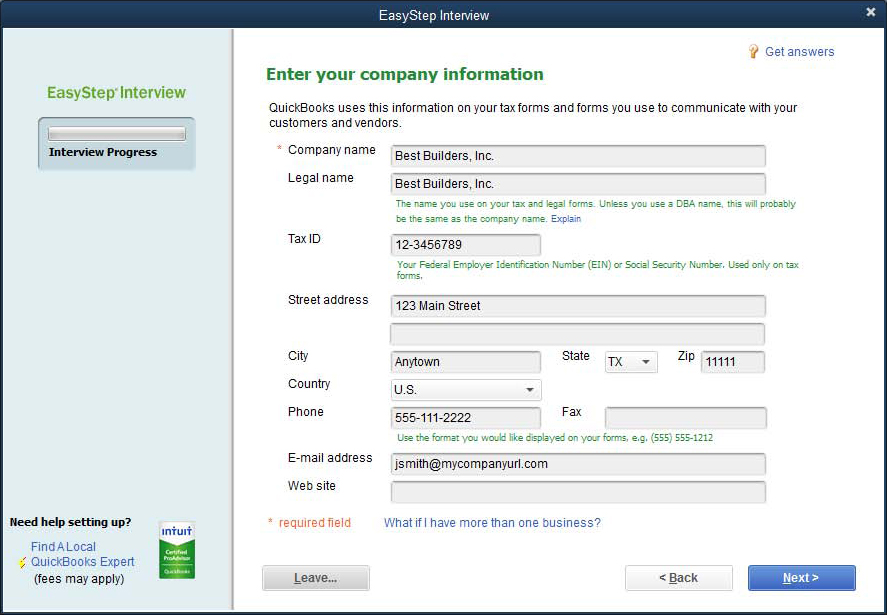
If you need to leave the EasyStep Interview at any time after saving the file, QuickBooks returns to the point where you left off when you open the data file again.
The EasyStep Interview now prompts you for certain information based on what industry you selected. Your answers to the remaining questions will make certain features in QuickBooks the default. The purpose of this chapter is not to define each of these choices; most are self-explanatory or are included in various chapters in this book. However, discussing the effect of several important choices is useful at this time.
Using Advanced Setup or Detailed Start
You may prefer to have a bit more control of the setup process up front. This is exactly what the Advanced Setup (also known as the EasyStep Interview) offers.
To create a new file using Advanced Setup, from the menu bar, click File, Create a New Company, and then in the QuickBooks Setup dialog box, click the Advanced Setup button. Alternatively, in the No Company Open dialog box, click the Create a New Company button, and then click the Advanced Setup button.
You then enter the following information when creating the new data file:
• Enter Your Company Information—Enter your Company Name, Legal Name, Tax ID, and other information that can be included on customer invoices and other forms within QuickBooks. Click Next.
• Select Your Industry—QuickBooks can help you get started quickly by providing basic information for particular industries (see Figure 1.8). Pick an industry that closely matches your own. Click Next.
Figure 1.8. QuickBooks includes customized settings for your specific industry.

• How Is Your Company Organized?—Select the legal organization your company selected when obtaining your Federal Identification Number. This choice creates unique Equity accounts to match your legal selection. Click Next.
Note
Do not worry if you cannot complete the entire set of questions at one time. After QuickBooks creates the file, you can click the Leave button. QuickBooks saves your choices and when you reopen QuickBooks, you return to where you left off.
• Select the First Month of Your Fiscal Year—Select the month your fiscal year starts in. Some reports will display the correct fiscal year dates by default when you select this option. Click Next.
• Set Up Your Administrator Password—It is recommended that you set up an administrator password. If you do not set one during the EasyStep Interview, you can open a QuickBooks file with the default username of Admin and leave the password blank. Using a blank password is fine during the initial setup, but you should put more security in place after you enter sensitive information. You can also set up or change this password later. Click Next and QuickBooks creates your company file.
• Create Your Company File—QuickBooks requires that you decide where to store the company data file and provide a name for the file. Click Next. Browse to select a location to store your file or accept the default location and name suggested by QuickBooks. Click Save. QuickBooks displays a progressive message that your file is being created.
• Customizing QuickBooks for Your Business—After reading the information, click Next.
• What Do You Sell?—Choose from Services, Products, or Both Services and Products. This preference affects the type of default invoice form that is selected when you begin using QuickBooks. Click Next.
• Do You Charge Sales Tax?—Specify whether you want to charge sales tax, choosing from the Yes or No option button. (You can change this later if necessary). Click Next.
• Do You Want to Create Estimates in QuickBooks?—Select either the Yes or No option button. If you provide a proposal to your clients or multiple proposals, you will want to enable this feature. Click Next.
Note
Not certain which choice to make when completing the Advanced Setup (EasyStep Interview)? No worries; QuickBooks selects the recommended option based on the industry you selected in step 2.
• Tracking Customer Orders in QuickBooks—Choose either the Yes or No options. (This feature is available only in QuickBooks Premier, Accountant, or QuickBooks Enterprise Solutions.) Click Next.
→ For more information, see “Using QuickBooks Sales Orders,” p. xxx.
• Using Statements in QuickBooks—Choose between Yes or No. This option enables you to print past-due statements for your customers. Click Next.
• Using Invoices in QuickBooks and Using Progress Invoicing in QuickBooks—Select Yes or No. Selecting Yes enables the use of customer invoices. In selected industries, you might also be prompted to enable progress invoicing. Progress invoicing is “milestone billing” (when you invoice a customer progressively during a job).
• Managing Bills You Owe—Choosing Yes enables the capability for you to enter vendor bills and pay those bills at a later date. Click Next.
→ Working with vendors is discussed in Chapter 7, “Setting Up Vendors.”
• Tracking Inventory in QuickBooks—Select either Yes or No to enable this feature. Remember, these features can later be enabled in Preferences. Click Next.
→ To learn more about inventory, see Chapter 5, “Setting Up Inventory” and Chapter 6, “Managing Inventory.”
• Tracking Time in QuickBooks—Tracking time enables you to bill customers for time, analyze time on projects, and pay salary or hourly employees or hourly paid vendors. Select either Yes or No. Click Next.
• Do You Have Employees?—Choose either W-2 employees or 1099 contractors. If you selected Yes to W-2 employees, QuickBooks will create the needed Chart of Accounts items. This setting can be modified later. Click Next.
• Using Accounts in QuickBooks—Click the link “Why Is the Chart of Accounts Important” to learn more about this list in QuickBooks. Click Next.
→ This list is also discussed in Chapter 4, “Understanding QuickBooks Lists.”
• Select a Date to Start Tracking Your Finances—Choose from Beginning of This Fiscal Year: 01/01/2016 (for example) or Use Today’s Date or The First Day of the Quarter or Month. These are examples of potential start dates.
• You start using QuickBooks immediately upon starting your business with no prior expenses or income. This date is the easiest one to work with because you have no historical balances or transactions to consider. You begin by paying vendors and invoicing customers. Everything else falls into place.
• At the beginning of a calendar year, such as January 1, 20xx. This choice is common when the decision to begin using QuickBooks is at the end of a year or not very far into the new year. Again, if the company has previously had business transactions, there will be beginning balances to enter.
Tip
If you selected the incorrect first month of your fiscal year during the EasyStep Interview, you can easily change it by selecting Company, Company Information from the menu bar. Changing this month does not affect individual transactions but does ensure that the reports that are based on a fiscal year are correct.
→ To learn more, see “Setting Up a QuickBooks Data File for Accrual or Cash Basis Reporting,” p. xx.
• At the beginning of your fiscal year, (for companies whose tax year does not coincide with the calendar year).
• The first day of a month during the current calendar or fiscal year. Click Next when you’re finished with this selection.
• Review Income and Expense Accounts—You are provided the opportunity to include or exclude certain default charts of account from your new data file. Click Next.
• Congratulations—You are finished with the Advanced (or Detailed) Setup. Click Go to Setup.
• You’ve Got a Company File!—You can now add contacts, products, services, and bank accounts as discussed in the “Express Start” section earlier in this chapter.
Creating a New File from an Existing Company File
Available with QuickBooks Accountant and QuickBooks Enterprise Solutions Accountant is the option to use an existing QuickBooks data file to create a new data file, as shown in Figure 1.9. Your original file is left unchanged in the process.
Figure 1.9. Convenient tool for accounting professionals who have a template file they want to copy for their clients to use.
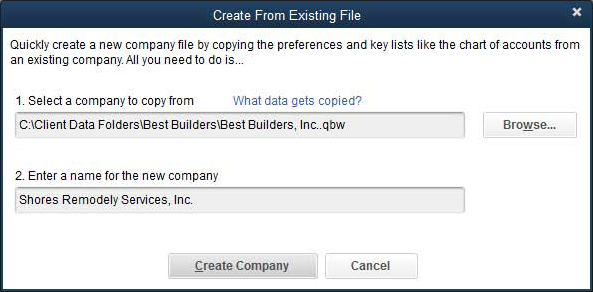
Note
The capability to create a new file from an existing file referenced in step 1 is available only if you are creating a new file from the Accountant 2013 or Enterprise Solutions Accountant 13.0 software or newer.
To create a new file from an existing file, follow these steps:
1. From the QuickBooks Setup dialog box, click the Create button. The Create from Existing File dialog displays.
2. By default, the currently opened company is selected as the file to be copied from. To select a different QuickBooks file, click the Browse button.
3. Type a Name for the new company file.
4. Click Create Company.
5. Accept the default filename and location for saving your new file, or modify as needed.
6. Click Save.
Using the Create from Existing Company File process, QuickBooks copies the following information, from one file to another:
• Preferences—Not including those for bank or credit card accounts.
• Items List—Only sales tax items, no products or services.
• Memorized Reports—Only those that do not filter for specific accounts, customers or jobs, vendors, items, or employees.
• Type of Tax Form—Useful if you are going to integrate with tax preparation software.
• Chart of Accounts—No bank accounts are copied.
If you find that you wanted more details copied from the original file, or wanted to remove a specific year’s transactions, ask your accounting professional to use QuickBooks Accountant 2014 software and provide you with a newly created “Condensed Data” file.
Hopefully, you found one of the three options best for your needs in starting your new QuickBooks file. The next section in this chapter covers converting other accounting software to a QuickBooks file.
Tip
Not using the Accountant version of QuickBooks software? Or, would you like to be able to copy the products and services from one file to another? Consider using the IIF (Intuit Interchange Format) export. From the menu bar, select File, Utilities, Export, Lists to IIF Files.
With this option, you are able to select a specific list (not transactions) that you want to import into another QuickBooks file.
Converting from Other Accounting Software
QuickBooks has automated the process of converting files from other financial software into QuickBooks files. Other programs you can convert from include the following:
• Quicken
• Peachtree by Sage (recently renamed Sage 50)
• Microsoft Small Business Accounting
• Microsoft Office Accounting
This section provides specific details about how QuickBooks handles the conversions and what you need to consider when making the choice to convert existing data from one of the listed financial software programs to a QuickBooks data file.
Before converting your company data to QuickBooks, make sure you have QuickBooks installed and registered/licensed and updated to the latest release. For more information, see “Managing Your QuickBooks Database,” p. xxx.
Even with the automation of the process, you should consider finding a QuickBooks Certified ProAdvisor in your area to assist with the conversion. From the Help menu in QuickBooks, select Find a Local QuickBooks Expert.
Converting from Quicken to QuickBooks
To begin the conversion from Quicken, open QuickBooks, from the menu bar, select File, New Company, and then from the Other Options drop-down list in the QuickBooks Setup dialog box, select Convert Quicken Data. The Conversion tool copies your Quicken data to a new QuickBooks file, leaving your original Quicken data file unchanged.
Table 1.2 shows you how the Quicken accounts are converted into QuickBooks accounts.
Table 1.2. Quicken Account Conversion
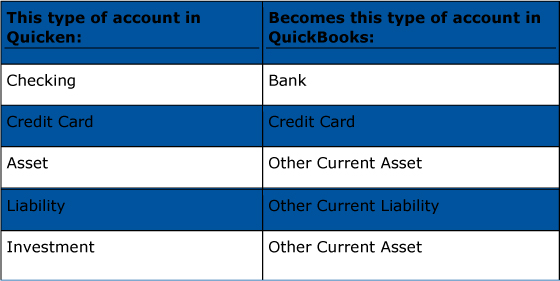
Because QuickBooks does not offer the Investment tracking feature that is in Quicken, you can choose whether to include or exclude the value of your investments in the resulting QuickBooks balance sheet. If you choose to include them, QuickBooks converts the investment accounts into the Other Current Asset chart of account type.
If you choose to exclude the investments, you are given the opportunity to delete the accounts before converting to QuickBooks. Any transfers that were recorded to or from the deleted accounts are recorded to your Opening Balance Equity account. This is in keeping with the “debits equal credits” accounting that is going on behind the scenes in QuickBooks.
During the conversion process QuickBooks asks you whether a Quicken Accounts Receivable account with customer payments exists. If you click Yes, the QuickBooks Conversion tool asks you to identify your Quicken Accounts Receivable account. QuickBooks then begins converting the Quicken transactions to QuickBooks Accounts Receivable transactions. This process can take several minutes.
During the conversion:
• QuickBooks creates an Opening Balance Equity account to compensate for deleted Quicken accounts.
• Memorized Invoices in Quicken might need to be reviewed, making sure the items memorized in Quicken remain on the invoice in QuickBooks.
• Duplicate check, invoice, or credit memo numbers are stored in a QBwin.log for review. You learn more about this log in Chapter 17.
• Every payee name in Quicken must be on a QuickBooks list.
Caution
After you click OK to change the name type, you cannot undo the change. If you are not sure what list the payee belongs to, leave it as an Other Name. Because QuickBooks cannot determine which list an item belongs to, the conversion places all items on the Other Name list (see Figure 1.10).
Figure 1.10. After converting from Quicken, you will need to reassign most of the names on the Other Names list to the Customer, Vendor, or Employee Lists.
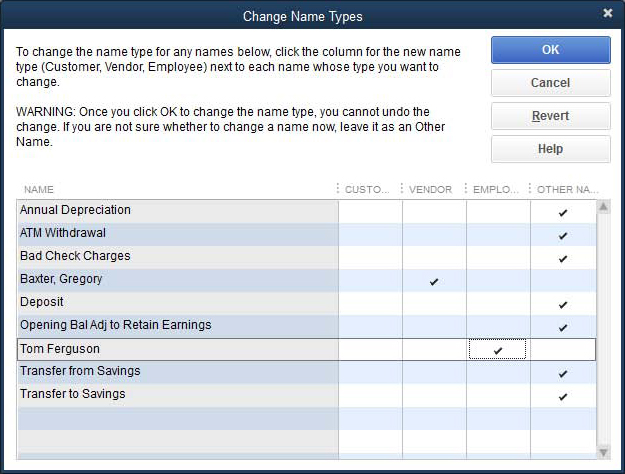
From the menu bar, select Lists, Other Names List to open the Other Name List dialog box. Right-click this dialog box and then select Change Other Name Types for a one-time option to change the payee from an Other Name list item to a vendor, employee, or customer. If you do not need to use a name on vendor transaction or customer form, you can leave the name on the Other Names list.
Converting from Peachtree, Small Business Accounting, or Office Accounting to QuickBooks
Just as in the Quicken conversion, QuickBooks can convert your Peachtree/Sage 50, Small Business Accounting, or Office Accounting data to QuickBooks data directly from the Options drop-down menu on the QuickBooks Setup dialog box. The conversion process leaves your original Peachtree/Sage 50, Small Business Accounting, or Office Accounting data untouched.
To download the free conversion tool, follow these steps:
1. From the menu bar, select File, New Company or, alternatively, in the No Company Open dialog box, click the Create a New Company button. The QuickBooks Setup dialog box displays.
2. From the Other Options drop-down list, select Convert Other Accounting Software Data; you will need an Internet connection to complete this step.
3. Follow the helpful links to download the free conversion tool or to read the Conversion Tool FAQs document.
The free downloadable tool converts Peachtree/Sage 50 (2001–2011), Microsoft Small Business Accounting, or Office Accounting. The tool can be used to convert multiple company files from any of the named software.
The technical whitepaper available when downloading the free conversion tool is outdated as of the writing of this book, but still provides useful information about the conversion details.
In the conversion process, you can select the specific Peachtree/Sage 50, Microsoft Small Business Accounting, Microsoft Office Accounting, or Office Accounting Express file and the QuickBooks product version to which you will be converting it. Additionally, you can specify the conversion of lists and transactions (including historical transactions) or lists only.
You also choose a conversion date; any transactions dated after this date will not be converted.
Because of the differences between the two products, you are also given a choice to identify customers and vendors in QuickBooks with the name of the Peachtree/Sage 50, Microsoft Small Business Accounting, Microsoft Office Accounting, or Microsoft Office Express ID value. You must choose to use the name or the ID value in QuickBooks, so it’s best to make this decision before performing the conversion.
Key lists that are converted include the following:
• Chart of accounts
• Customer/prospects
• Jobs
• Employees/sales reps
• Vendors
• Inventory item
• Custom fields
• Balance information
Open transactions include the following:
• Open invoices
• Open vendor bills
Customer transactions include the following:
• Estimates
• Sales orders
• Invoices
• Payment receipts
• Deposits
• Credit memos
Vendor transactions include the following:
• Purchase orders
• Bills
• Bill payments
• Checks
• Bill credits
Setting Up Users and Permissions
QuickBooks always creates a default user with the username Admin. The Admin user has full rights to all settings and preferences in QuickBooks. If your company is going to have multiple users accessing the QuickBooks data file, it is recommended that you create a unique user login for each person and assign specific permissions if needed. With unique usernames for each person, QuickBooks will be able to tell you who entered, modified, or deleted a transaction on the Audit Trail report.
Enable multiuser access if you want to have two or more users access your QuickBooks files simultaneously.
→ For more information, see “Changing to Multiuser Access,” p. xxx.
Note
Table 1.1 listed the number of users who can work in a company file at the same time, based on the version of the software that you have. If you need to buy additional licenses from the menu bar choose Help, Manage My License, Buy Additional User License.
External Accountant
Business owners who plan to share data with their accountant at tax time or for other purposes should create a unique user for your accountant. The External Accountant user type has all the controls of the Admin, except that the accountant cannot do the following:
• Add, delete, modify, or view sensitive customer credit card details
• Add, delete, or modify other QuickBooks user settings
To create a user login for your accountant, follow these steps:
1. From the menu bar, select Company, Set Up Users and Passwords, Set Up Users.
2. In the User List dialog box, click the Add User button.
3. Enter a User Name and Password (optional but recommended) and then enter the password again to confirm.
4. If you need to add additional licenses to your QuickBooks file, click the Explain link for more information about Intuit’s licensing policy.
5. Click the Next button. If you didn’t enter a password in step 3, QuickBooks opens the No Password Entered dialog box. Click Yes to create a password or No to skip this step.
Tip
If you are an accounting professional using QuickBooks Accountant 2014, you can use the QuickBooks File Manager 2014 to store your client’s assigned username and password for you. When you open the client’s file from within File Manager, QuickBooks automatically logs you in, bypassing the username and password dialog. This works with QuickBooks Pro, Premier, or Enterprise 2011 or newer files.
6. Select the External Accountant option button, as shown in Figure 1.11, and click Next to continue.
Figure 1.11. Creating an External Accountant user for your accounting professional limits access to sensitive customer information.
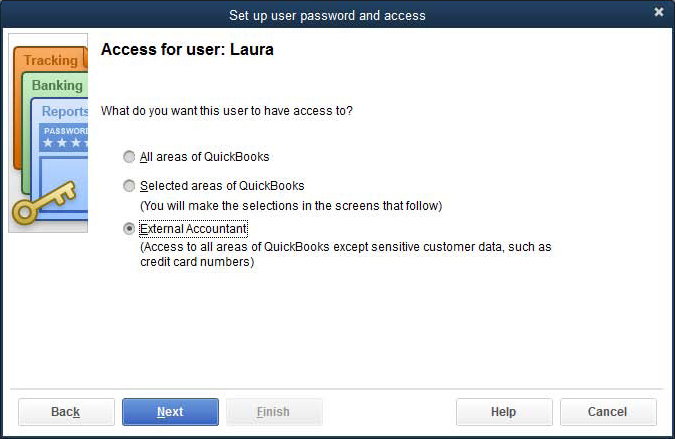
7. In the Warning dialog box, click Yes to confirm you want to give the user access to all areas of QuickBooks, except credit card information.
8. Click Finish. If a Warning dialog box opens, click OK to confirm that you understand that the Admin user is being assigned to integrated applications.
9. Click Close to close the User List dialog box.
To log in to the file as the new External Accountant user, from the menu bar, select File, Close Company/Logoff. From the No Company Open dialog box, select the file from the list. Click Open and enter the username and password.
Other QuickBooks Users
Setting up users with permissions is recommended when you have multiple users working in the same QuickBooks file. Transactions are assigned to users and many changes to the file are also tracked to the user who logged in to the file.
To create a user login and set permissions for additional users, follow these steps:
1. From the menu bar, select Company, Set Up Users and Passwords, Set Up Users.
2. From the User List dialog box, select Add User.
3. Enter a User Name and Password (optional but recommended) and enter the password again to confirm.
4. If you need to add additional licenses to your QuickBooks file, click the Explain link.
5. If you didn’t enter a password, click Yes to create a password or No to skip this step.
6. Select the access option:
• All areas—Provides access to all areas of QuickBooks except those which require Admin access.
• Selected areas—Allows you to choose the options for access to each sensitive area of your QuickBooks data.
7. You now work through nine permission screens and on the tenth screen (see Figure 1.12) you can review the permission settings. Each dialog box offers details about the access levels and most include some or all of the following permission levels:
• No Access
• Full Access
• Selective Access—Includes all or some of these options:
• Create transactions only
• Create and print transactions
• Create transactions and create reports
Figure 1.12. You can review a summary of the access rights assigned to a QuickBooks user.
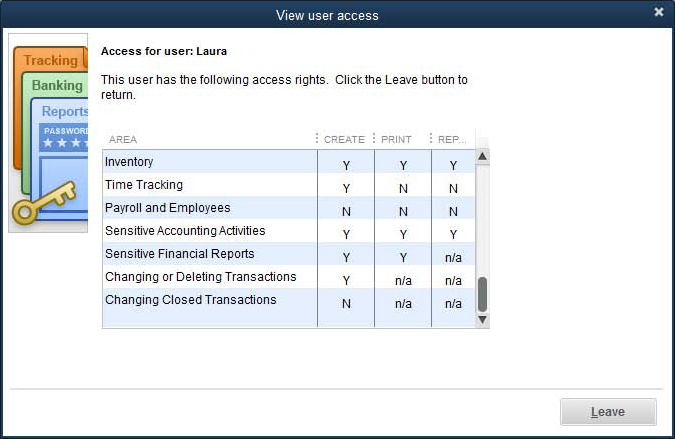
If you are uncertain about the limitations of a permission setting in QuickBooks Pro or Premier, I recommend you set it for the Create Only option—the highest level of security. Then log in as that new user and attempt to access an area the employee will work in or an area she shouldn’t be in to determine if the permissions assigned provide the controls you need. QuickBooks will tell you what level of permission is needed for any task you attempt.
Note
Are you a QuickBooks Pro and Premier user intrigued by the extensive user security available in QuickBooks Enterprise? No worries; upgrade your data file to QuickBooks Enterprise with just a click. All your previous data will be available in QuickBooks Enterprise software. The user interface and menus in Enterprise are similar to QuickBooks Pro and Premier so you do not have to learn to use new software! For more information, see “Upgrading Your QuickBooks Version,” p. xxx.
User Security in QuickBooks Enterprise
If you have users other than yourself accessing QuickBooks enterprise data, you’ll surely want to implement security controls. QuickBooks Enterprise allows granular control over user access to tasks, reports, and features.
QuickBooks Enterprise offers far more robust access control than QuickBooks Pro or Premier.
Overview
QuickBooks Enterprise Solutions provides the capability to safeguard sensitive business data by giving employees access only to the specific information they need. These controls are robust with the capability to set individual user permissions for more than 115 different tasks in QuickBooks.
To use the QuickBooks Enterprise user security settings, you need to complete these steps:
1. Add to or modify the supplied user roles.
2. Set up named users.
3. Assign a role or multiple roles to the named user.
When defining access rights, you are modifying specific activity rights within an Area in QuickBooks. Areas are defined as a group of related tasks. Areas include the following:
• Accounting
• Banking
• Centers
• Company
• Customers & Receivables
• Employees & Payroll
• File
• Lists
• Reports
• Time Tracking
• Vendors & Payables
The next section discusses how to set up or modify user roles in QuickBooks Enterprise.
Set Up and Modify User Roles
In QuickBooks, a user role permits, limits, or blocks a user’s access to reports, transactions, lists, centers, and so on. Roles can represent positions within a company and can be assigned to multiple QuickBooks users. QuickBooks Enterprise comes with these predefined roles (similar to a position title) that can be modified (unless otherwise noted):
• Accountant
• Accounts Payable
• Accounts Receivable
• Admin (cannot be modified)
• Banking
• External Accountant (cannot be modified)
• Finance
• Full Access
• Inventory
• Payroll Manager
• Payroll Processor
• Purchasing
• Sales
• Time Tracking
• View-only
These roles have predefined, modifiable security settings for specific activities related to that feature area. With roles, you can do the following:
• Create a New Role
• Edit an Existing Role (except as noted previously)
• Duplicate an Existing Role
• Delete a Role
The first step is to review the permissions assigned for a specific role or, optionally, create a new role. It is often easier to select an existing role and modify it. To modify an existing role in your file, follow these instructions:
1. Log in to the QuickBooks file as the default Admin user, as discussed earlier in this chapter.
2. From the menu bar, select Company, Users, Set Up Users and Roles. The Users and Roles dialog box displays with the User List Tab selected.
3. To modify or create a Role, select the Role List tab. For this example, the Role Name of Accounts Payable was selected.
4. Click the Edit button on the right. The Edit Role dialog displays with the following information, as shown in Figure 1.13:
• Role Name—This is the name you’ll see when you choose from a list of roles to assign to a user.
• Description—Provide an overview of the role’s rights and restrictions.
• Area and Activities—Functional groupings of QuickBooks activities. Each area’s general access level is noted by the coloring of the icon in front of the area, per the following:
• Shaded Circle—Indicates that all activities in this area are allowed Full Access rights for the selected role.
• Partially Shaded Circle—Indicates that some activity restrictions exist in that group for the selected role.
• Nonshaded Circle—Indicates no access to any of the activities in this area.
• Area Access Level—Assign more granular access controls.
• None—No access to the selected Role Access Activity.
• Full—Complete, unlimited access to the selected Role Access Activity.
• Partial—View option, as well as access to Create, Modify, Delete, Print, View Balance, and other options unique to the selected Role Access Activity.
Figure 1.13. Edit the security settings for an existing Role.
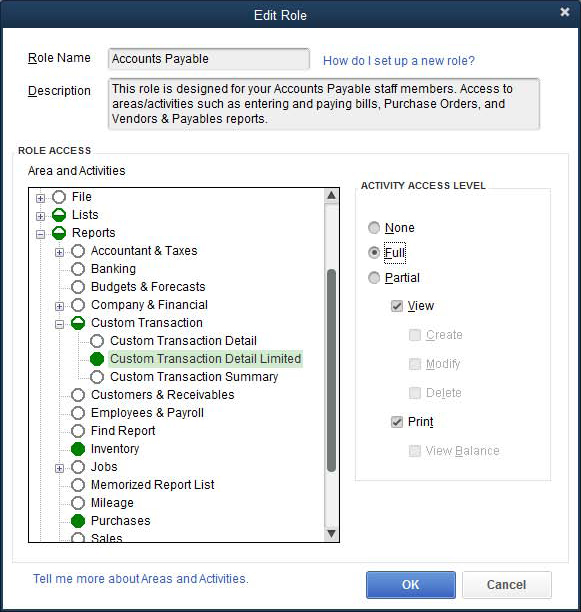
5. For this example, in the Area and Activities panel, select the minus sign (–) in front of Custom Transaction to expand the choices. Choose either: Full or Partial options and whether the user can both View and Print the report. You choices will differ depending on the specific activity you have selected. See Figure 1.14.
Figure 1.14. Define granular user security settings with QuickBooks Enterprise.

Select the activity and then choose the preferred activity access level
6. Make any other modifications to this Area and other Areas and Activities as needed. When finished with the changes, click OK.
After a role is created or modified, it can be assigned to one or more users of the company file. Conversely, a user can be assigned multiple roles.
Tip
Do you want to provide users with the opportunity to create reports, but not have the report display information they do not have access to? When defining role access, in the Area and Activities section, select Custom Transaction and choose the Custom Transaction Detail Limited option, as shown in Figure 1.14.
Note
Are you uncertain how many User Licenses you have with your QuickBooks Enterprise software? With the file open, on your keyboard press F2 to display the Product Information dialog. Near the top and to the left the number of User Licenses will be listed. QuickBooks Enterprise offers simultaneous use by 2–30 users.
For example, to prevent a user from accessing sensitive payroll information, you must set user access levels as shown in Table 1.3 for the role assigned to the user.
Table 1.3. Limiting Access to Payroll
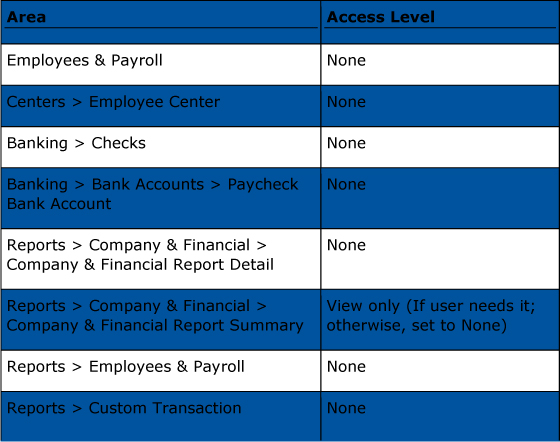
Now that you have set up roles that have the desired security settings for Activities, you can create users and assign these roles to the users.
Set Up Users
After creating or modifying user roles, you are ready to add named users to the file and assign the user roles to them.
1. Log in to the QuickBooks file as the default Admin user, as discussed earlier in this chapter.
2. From the menu bar, select Company, Users, Set Up Users and Roles. The Users and Roles dialog box displays with the Users Tab selected.
Caution
When someone no longer works for your company, resist the urge to delete the person’s name. If you remove the name, transactions entered or modified by this user will be listed as “unknown user” on the audit trail reports. Instead, change the user’s password and access level. Only active users in your file count toward your licensed user limit.
3. Select User List tab. From this tab you can do the following:
• Add a new user
• Edit an existing user’s settings
• Duplicate an existing user’s settings for ease in adding a new, similar user
• Delete a user (not recommended), instead if a user no longer is with the company: simply remove the user’s roles.
4. Select New. The New User dialog displays.
5. Type a User Name. This is the name the user will need to type to log in to the data file. The name typed is not case sensitive, but it must be spelled exactly as it is listed here, including any spaces.
Tip
You can print a report detailing the permissions by employee or role. From the Users and Roles dialog box, click the View Permissions. You can choose to show permissions for the User or Role. Click Display to view the details.
6. Type a password (optional but recommended). This password is case sensitive.
7. Type the password again to confirm.
8. From the Available Roles list, select the applicable roles for this individual’s duties in the QuickBooks file. Click the Add button to assign the selected Role to the Assigned Roles list to the right.
9. Click OK when you are finished with assigning Roles to the selected new user name.
10. You may get a warning message if you have previously instructed QuickBooks to log in to the file automatically. Click OK to close the message. You are returned to the User and Roles list displaying the newly created user and the roles assigned, as shown in Figure 1.15.
Figure 1.15. From the Users and Roles dialog, you can see who is logged into the file and the roles assigned to each of the users.
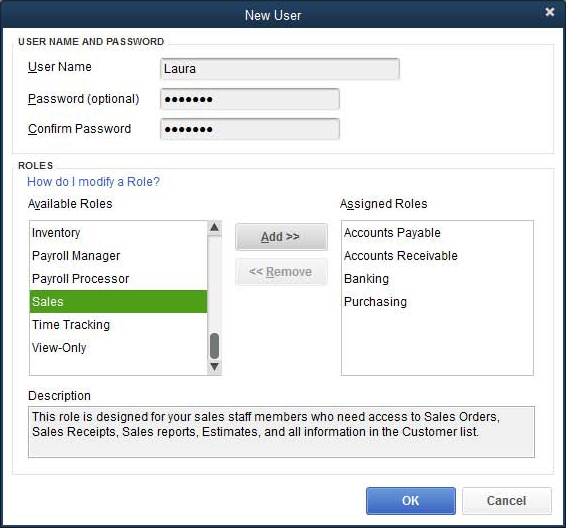
Reporting on User Activity
Setting up users with the proper security access is important for any company that wants to have controls in place with its accounting data.
You can use these reports to track transactions that have been added, modified, or deleted using these reports accessible from the menu bar, by choosing Reports, Accountant & Taxes:
• Audit Trail—Listing of all transactions added or modified, grouped by username. You can learn more about this report in Chapter 15, “Reviewing Your Data.”
• Closing Date Exception Report—Provides details of when the closing date was set or removed and transactions that were altered on or before the set closing date. More about working with the closing date can be found in Chapter 16, “Sharing QuickBooks Data with Your Accountant.”
• Customer Credit Card Audit Trail—If you track credit card numbers for your customers in QuickBooks, you can enable credit card security and prepare reports on who accessed this sensitive information. To enable this security for your file, from the menu bar, choose Customer Credit Card Protection.
• Voided/Deleted Transactions Summary—This report cannot be filtered to remove the information. For more information, see Chapter 15, “Reviewing Your Data.”
• Voided/Deleted Transactions Detail—This report cannot be filtered to remove the information. For more information, see Chapter 15.
Additionally, if you are using QuickBooks Accountant 2014 or QuickBooks Enterprise Solutions Accountant 14.0, you have access to Client Data Review, which includes a tool to track changes to lists. The previously listed reports do not report on changes to lists. See Appendix A, “Client Data Review,” for more details.
With QuickBooks 2014, you have gotten off to a quick start in setting up your new file (or converting from other accounting software) and setting up users with specific permissions. You will also find it helpful to use the QuickBooks sample data when you want to practice or follow along with much of the content in this book.
